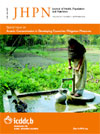
|
The Journal of Health, Population and Nutrition
icddr,b
ISSN: 1606-0997
EISSN: 1606-0997
Vol. 36, No. 1, 2017, pp. 1-10
|
 Bioline Code: hn17033
Bioline Code: hn17033
Full paper language: English
Document type: Review Article
Document available free of charge
|
|
|
The Journal of Health, Population and Nutrition, Vol. 36, No. 1, 2017, pp. 1-10
| en |
Engaging men to promote and support exclusive breastfeeding: a descriptive review of 28 projects in 20 low- and middle-income countries from 2003 to 2013
Yourkavitch, Jennifer M.; Alvey, Jeniece L.; Prosnitz, Debra M. & Thomas, James C.
Abstract
Background: Lay support has been associated with improved breastfeeding practices, but studies of programs that
engage men in breastfeeding support have shown mixed results and most are from high-income countries. The
purpose of our research is to review strategies to engage men in exclusive breastfeeding (EBF) promotion or
support in 28 project areas across 20 low- and middle-income countries. This information may be used to inform
program implementers and policymakers seeking to increase EBF.
Methods: We tested the difference between baseline and final EBF proportions using Pearson’s chi-square (a = 0.05)
and identified project areas with a significant increase. We categorized male engagement strategies as low- and
high-intensity, using information from project reports. We looked for patterns by intensity and geography and
described strategies used to engage men in different places.
Results: Twenty-eight projects were reviewed; 21 (75%) were in areas where a statistically significant increase in EBF
was observed between the beginning and end of the project. A variety of high- and low-intensity male engagement
strategies was used in areas with an increase in EBF prevalence and in all geographic regions. High-intensity strategies
engaged men directly during home or health visits by forming men’s groups and by working with male community
leaders or members to promote EBF. Low-intensity strategies included large community meetings that included men,
and radio messages, and other behavior change materials directed towards men.
Conclusion: Male engagement strategies took many forms in these project areas. We did not find consistent
associations between the intensities or types of male engagement strategies and increases in EBF proportions. There is
a gap in understanding how gender norms might impact male involvement in women’s health behaviors. This review
does not support the broad application of male engagement to improve EBF practices, and we recommend
considering local gender norms when designing programs to support women to EBF.
Keywords
Exclusive breastfeeding; Male involvement; Gender
|
| |
© Copyright 2017 - The Author(s)
Alternative site location: http://www.jhpn.net
|
|
